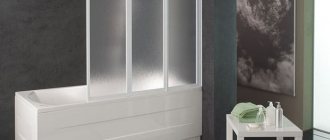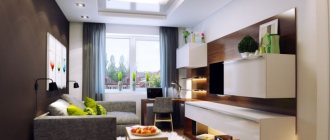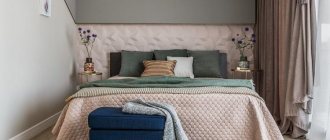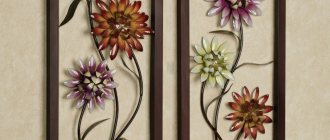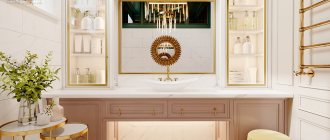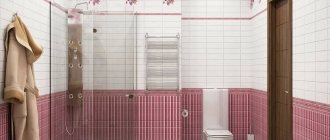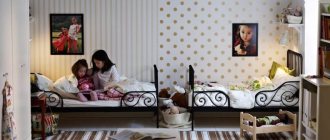Decorative screens are considered a classic attribute of interiors. They are intended for visual zoning of space, and also perform an aesthetic function. Modern models are made in different variations and from different materials. Screens are used in any room of the apartment in accordance with the chosen interior style.
No. 1. A little history
Screens have come a long way before becoming firmly established in modern society and gaining general recognition among both ordinary people and famous interior designers. They came to us from distant times. the birthplace of screens . Initially, people covered the entrance to their homes with fabric screens with beautiful paintings. They believed that it served as protection and would never allow unclean and evil spirits into their house. The screens were decorated with beautiful stones and shells, they had gorgeous patterns embroidered on them, they were loved and tried to be made as beautiful as possible. A little later, the fashion for screens reached Japan.
Japanese screens were made of durable paper. They were painted with paints, depicting fabulous and mighty dragons or majestic tigers. From there, the fashion for screens moved to India. The Indian screens looked simply unbeatable! Skillful, delicate, openwork wood carving made them a real work of art. And only in the 17th century the first screens began to appear in Europe . True, initially they were used only as beautiful interior elements, and only in the next century these beauties found practical use. Beautiful women excited the minds of men when they walked behind the screen to put on evening attire, and the shadow of their silhouette was clearly visible through the material.
Savio Firmino 3015
Only the best varieties of natural wood become the raw material for Savio Firmino furniture and accessories. All carved decorations are created by hand by artisans from Florence. This screen is presented in a soft cream color and decorated with molded decorative elements. It will look perfect in a bedroom decorated in a classic style.
In the photo: classic screen Savio Firmino 3015 .
No. 2. Deciding on the type of screen
To make it easier for you to navigate, here are the main options for possible screens and some tips for using them in the interior:
- Sash screens . These are the simplest and most common, very light and mobile designs. They, as a rule, consist of a frame made of metal or wood, onto which the material of the future screen is attached, and has several doors. The principle is similar to a window frame. This screen is easy to unfold; if necessary, it can be moved anywhere, depending on your need at that particular moment. It's very simple, easy and convenient. For example, your significant other is already asleep, and you really want to sit next to you in a chair and read a book, but are you afraid to disturb the sleeper’s peace by turning on the lamp? A folding screen will easily solve your problem. In addition, folding screens can be of completely different sizes; you can make it either the entire length of the room or just a few sections. The price of such screens will also please you.
- Single-leaf screens . They are very different in design from folding screens, as you could probably guess from the name. Such screens consist of only one frame, but this makes their functionality and possible external beauty no worse. They can be made of absolutely any material or even have shelves! And such screens have long been very common in medical institutions, in large offices, in beauty salons, as well as in small cute cafes, but, unfortunately, few people pay attention to this.
- Flexible screens . This is probably the most interesting and unusual type of screen. They can take on the most unique forms, and you can change them every day depending on your mood. Such screens are made either from thin, flexible tapes arranged vertically or horizontally on the frame, or in the form of an accordion. The latest very interesting new product on the market is the book screen. It looks very impressive, and most importantly, you can stretch it to any length, naturally within its capabilities.
- Mirror screens . Everything is clear here. These are screens, the design of which necessarily contains an element such as a mirror. Many will say that this is a thing of the past, not fashionable and ugly, because almost all modern wardrobes have mirrored facades, but we are willing to bet. Firstly, not everyone nowadays gives their preference to large wardrobes, at least in the bedroom. After all, a small screen with a central section made using a mirror, which will stand in the corner of the bedroom, will look much more interesting and neater. Behind such a screen you can hide a dressing table or separate an area with shelves for clothes from the total area of the room. Secondly, a mirror screen in the interior of a small room will help to visually enlarge it;
- Screens as a decorative element . Here, as they say, there is room for the soul to roam. The appearance, color, material, shape, scope and practicality of such screens will depend entirely on the designer’s imagination or on yours, if the screen is made according to your sketch. They can resemble colored stained glass windows, your favorite photographs can be placed on them, and the screen itself will then resemble a large collage of photo frames. If you or your child is good at drawing, then use the screen as a canvas! Decorative screens can be non-portable and mounted directly into the wall; the walls of such a screen can be made of plexiglass, and between them there will be a colored liquid in which air bubbles will float. Yes, this can happen too!
Poltrona Frau Moucharabieh
This exquisite screen from designer Jean-Marie Massaud features a pattern of polygons of various shapes and sizes, representing a scaled-up detail of the grain of the leather. The structure of the model consists of frames with an aluminum profile, and the corners are made of steel and plastic. The name Moucharabieh comes from the word "mashrabiya". This is an element of Arabic architecture - patterned wooden grilles that cover windows and balconies from the outside, or are used as partitions inside the building.
In the photo: Poltrona Frau Moucharabieh
In hot countries, the mashrabiya grille provides unhindered penetration of fresh air into the premises, while reliably protecting from scorching sun rays without interfering with a good view of the surroundings. The details of the lattice insert panels are turned and assembled in such a way that they are impenetrable from the outside, but visible from the inside. It is widely believed that the mashrabiya was intended to separate the women's quarters from the rest of the house, or was used as a veil window for an oriental woman.
In the photo: mashrabiya, view from inside the Alhambra Castle in Granada and the Aljaferia Palace in Zaragoza.
No. 3. What function will the screen perform in the interior?
So that your choice is unambiguous and you do not begin to doubt after the purchase whether you did the right thing, you need to decide what exactly you want to achieve in the interior with the help of a screen.
Zoning
The vast majority of people purchase a screen precisely for this purpose. This is really the best option if the rooms in your apartment are long and rectangular, or if you are the owner of a studio apartment. Then the screen is just a salvation for you! After all, it will help to separate the dining area from the living room, the work area from the bedroom, and in the children's room to create a separate play area in which your child will feel cozy and comfortable. It is very easy to choose a screen for zoning. You have already become familiar with the types of screens. The main thing is that the screen either matches the style of your apartment as a whole or adds an original accent to it.
If you want
to separate the living area from the dining area, then you can choose a screen that has a beautiful pattern or photo print on one side, and functional shelves on the other.
Then on the kitchen side you will also have additional space to place any kitchen utensils. Do not forget that such a screen will most likely not be portable and must have a rigid, stable frame. If you decide to separate the work area from the bedroom, then on the side of your mini-office, you can make shallow niches in the screen and use them for books or stationery. It is most convenient to make such a screen from plasterboard, by the way, even with your own hands. Or, on the contrary, make the niches through so that light flows well through them into the sleeping area and place indoor plants. This will not only enliven the interior, but will also benefit your health.
A screen will also help to separate the sleeping area And only you can decide whether it will cover the entire length of the wall and be screwed directly to the floor, or whether it will be easily and quickly removed if necessary. In any case, it is very convenient and practical.
a separate place for games in the children's room by using a screen. To save space in a small room, you can make a textile screen and sew a lot of pockets on it, so there will be a lot of new space for toys, and folding them will turn into a real game, because each toy now has its own house!
There is even a place for a screen in the bathroom . Choose a screen made of clear or frosted glass and you can easily separate the bath or shower tray from the personal hygiene area. Such screens look very laconic and modern, and most importantly, they are very easy to clean.
Decor
Using a light, bright, beautifully decorated screen you can achieve a very big change in the appearance of your room. Decorative screens can be small in size and installed in a corner, close to the wall, without carrying any functional meaning. Or just stand along or in the middle of the central wall. If such a screen is carved, stained glass or has a bright pattern, then you can completely refuse wallpaper on the wall so that it does not distract attention. Perhaps it will be a fabric screen that will be attached to the ceiling and serve as a partition. Naturally, this is not your option; if you have suspended ceilings, do not forget about it. A screen standing by the window can easily replace curtains. I think in the process of reading, the image of your screen as an artistic interior decoration has already appeared before your eyes.
Practical use
Yes, screens can indeed have more functional uses than simple decoration or delimitation of space. These are screens that have additional shelves, pockets, sections for storing something, perhaps even hooks for clothes or bags and umbrellas. On some screens you can install an LED strip or buy a ready-made backlit screen; this will bring you an additional source of soft, dim light - just right for creating a romantic atmosphere.
Bathroom screens can be equipped with holders for towels or liquid soap dispensers, or even a cup for toothbrushes, or all at once.
Nobody says that a practical screen is necessarily bulky and ugly, under no circumstances. On the contrary, it is even a very smart investment of your money. Remember how much a set of bathroom accessories costs in a store? And by purchasing a functional screen, you get two in one!
A more complex version of partitions
Having certain skills, you can make a decorative screen with your own hands of a more complex design. This partition consists of several frames connected by hinges. They can be filled with anything .
First you need to decide on the dimensions and prepare the required number of slats. The cross-section of the slats can be 6 x 2. Each frame is assembled using glue. To do this, special grooves are cut out, marking them in width.
Using a hacksaw , make marks up to half the depth, selecting wood with a chisel. The frames are assembled, fixing the joints with clamps. Door hinges are attached to the top and bottom of the frames.
Next we move on to the decor. Using a stencil, a design is applied to a plain material. You can select a template from various sources. Cut out the stencil with a scalpel or wallpaper knife.
Apply the stencil to the fabric. Dip a small textile roller into the paint and run it over the stencil, each time laying the stencil in an arbitrary direction to make the design more picturesque.
Stretch the fabric onto the frame and secure it with staples using a stapler. From the inside, you can decorate the partition with platbands made of chipboard strips.
No. 4. Material selection
At this stage of reading, you should have already decided on the type and use of your screen, and the choice of material depends on this. Just keep a couple of simple principles in mind:
- If the screen is used in a room with high humidity, then it is definitely only moisture-resistant materials and glass.
- If this is a children's room, preferably something softer and possibly semicircular in shape; the fewer corners, the better and safer. Perhaps the screen will look like a large pillow and have a soft filling, then it will also be pleasant to lean on (don’t forget to attach it to the floor in this case).
- If you use the screen in any other room, then simply choose high-quality materials that you like.
Guided by these simple rules, you will choose something that will last you a very long time.
Giorgetti Ping
The Giorgetti Ping partition (in Chinese “ping” means “division”) is made of canaletto walnut wood with metal elements. Available with mirror and genuine leather inserts. The hinges and semicircular metal inserts are painted bronze. Spring-loaded rollers are mounted on the bottom of the screens to make them easier to move.
In the photo: luxurious Giorgetti Ping . A beautiful, high screen serves as both a partition and a decorative element of the interior.
No. 5. Light and mobile or durable and forever?
It's up to you to decide.
If you are a person with a very changeable mood, and it is common for you to change the interior of your apartment, or at least a room, almost every year, then a screen made of a welded metal frame that is attached to the floor and ceiling is unlikely to suit you. After all, installation and dismantling costs a lot of money, and you will receive an additional bonus in the form of holes in the floor and ceiling. Therefore, think for the last time and weigh the pros and cons, because no one knows you better than yourself! And may the screen you choose complement your interior exactly as you wanted and perform its functions to your delight! The article was written for the site.
Tags:Apartment design
Chelini 2159
For generations, Chelini has been known for the high quality of luxury furniture. The brand's design philosophy is based on classical culture and Tuscan traditions. The stylish Chelini 2159 screen will decorate your bedroom or living room. It is made of wood and decorated with a pattern of fern leaves.
In the photo: Chelini 2159 in a tropical style.
Extending service life - proper care
In order for the purchased item to last as long as possible, it is necessary to provide it with proper care.
The rules are quite ordinary and not difficult to follow.
- If the model is made of wood, then it must be wiped with a slightly damp cloth. Do not use products containing chemicals or aggressive substances. The main thing is to avoid the appearance of scratches, chips and damage to the integrity of the coating.
- It is better not to let the fabric surface become heavily soiled. Try to take care of it so that you don’t have to dismantle it. To do this, systematically clean the fabric with a vacuum cleaner. If a stain appears, it should be washed off immediately with a brush. If, nevertheless, the upholstery is heavily soiled, then it should be washed in a soft mode at a temperature of 300-400C.
- If the product is decorated with wallpaper or rice paper, then during operation it is worth protecting it from moisture. Basically. Such models are not durable, since over time they will become dirty, and it will be unlikely to clean them.
By following all the rules, you can significantly extend the life of your favorite item, which will create appropriate comfort and please the eye for many years.
We invite you to watch a short video tutorial about making a screen with your own hands.
© 2022 textiletrend.ru
Casement model
A classic product consisting of a durable frame, the elements of which are connected to each other either using piano hinges or parts made of thick fabric or leather.
The most common are three-leaf structures, but four-leaf ones are also found. The number of elements depends on the area of the room. The height of the product reaches 180-200 cm.
Decor
Let's look at the most common ways to decorate screens.
- Thread. This wonderful decor is usually used to decorate a wooden partition. Including a sliding accordion.
- Forging. Using this method, metal decorative models are decorated.
- Pockets - with their help, the screen is equipped with additional storage spaces.
- Decorative painting. This technique is most often used to decorate Chinese screens in a traditional style. As a rule, such a screen is black, varnished and decorated with elegant painting. They use floral ornaments, images of birds, animals, etc. In purely Chinese stylization, images of dragons, lanterns, and fantastic symbols are often used.
Beautiful wooden screen
